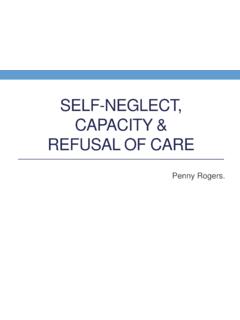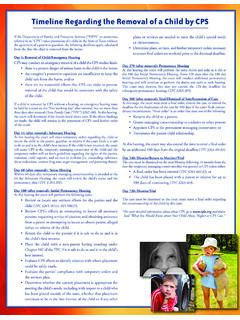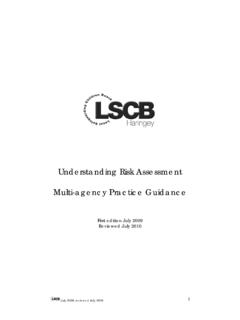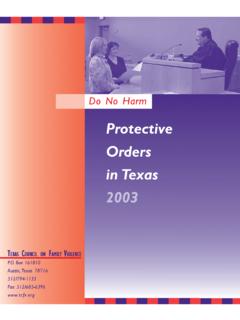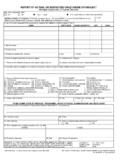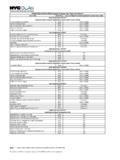Transcription of Bournemouth & Poole Local Safeguarding Children Board
1 Bournemouth & Poole Local Safeguarding Children Board Safeguarding and promoting the welfare of Children LSCB Levels of Need and Continuum of Support July 2016 Bournemouth & Poole Local Safeguarding Children Board Thresholds Principles The purpose of this guidance is to help agencies, that work directly or indirectly with Children , young people and families, identify a child s degree of need and respond appropriately. The guidance does not remove the need for workers to make a professional judgement when considering the identified needs of Children . This is guidance for the Multi-Agency Early Support and Safeguarding Thresholds with regard to meeting the needs of Children , young people and families in Bournemouth and Poole . Multi-Agency communication is the key to developing a full picture of the child and their family circumstances, using independent interpreters or signing services if necessary. If there are any queries, practitioners should seek advice and support from the Safeguarding Leads within their own organisation.
2 Sarah Elliott Independent LSCB Chair Bournemouth and Poole Local Safeguarding Children Board Foreword 2 Contents Guidance 4 2. Continuum of Need Model 5 3. Assessment Framework 6 4. Principles of Successful Intervention 7 5. Levels of Vulnerability & Need 8 6. Levels of Need and Continuum of Support 9 of Need and Intervention Criteria 10 3 All Children have the right to grow up safe from harm and the Children Act 1989 and 2004 place duties on all agencies to promote and safeguard the welfare of Children , in need and at risk, in their Local area. A child is defined within the Children Act 1989 as anyone who has not yet reached their 18th birthday. Practitioners should hold in mind that disabled Children are three to four times more vulnerable to abuse (Ofsted 2012). The Parent should be taken to refer to anyone who has parental responsibility for the child , or any birth/natural father or any other adult within the family who can reasonably be regarded as having a parenting role.
3 When there are issues of consent, it will be important to distinguish who has parental responsibility. The Children Act 1989 and 2004 encourages all agencies, wherever possible, to work in partnership with families and to make onward referrals with their consent. It is acknowledged that gaining consent when there are child protection concerns could at times place a child at further risk and the practitioner should gain advice, if time allows, from their Safeguarding Lead. Further guidance on Information Sharing can be found here. Sometimes Significant Harm will be a single traumatic event, but more often it is an accumulation of significant events, both acute and longstanding, such as in situations of persistent neglect. There are no absolute criteria in making judgements regarding Children 's wellbeing. Practitioners are encouraged to raise concerns, and escalate those concerns with other agencies, if they feel that their professional judgement about a child s needs or safety are being overlooked.
4 Refer as appropriate to the Escalations Policy here. The Designated Officer/s should be alerted, within one working day, to all cases in which an allegation that a person who works or volunteers with Children has: behaved in a way that has, or may have harmed a child ; possibly committed a criminal offence against Children or related to a child ; behaved towards a child or Children in a way that indicates that s/he is unsuitable to work with Children (Working Together 2015) When there is an immediate need to protect a child because they are being harmed or at risk of significant harm, the relevant Local Authority should be contacted promptly. Bournemouth Children s First: 01202 458101. Poole The Hub: 01202 735046. When there is an immediate risk to protect a child , call the Police on 999. For Pan Dorset Procedures visit: Key Guidance 4 Continuum of Need Model 5 This is guidance for everyone to use to support inter-agency working, information sharing and common assessment.
5 The Bournemouth and Poole Local Safeguarding Children Board (LSCB) has adopted this continuum of need model to provide a multi-agency, whole system approach to assessment, prevention and intervention for Children , young people and their families. It also directly supports the full implementation of Bournemouth and Poole s Assessment Framework. The adoption of the model provides consistency for professionals working across LSCB area. At no time must disagreement prevent a child from being safeguarded. If you are not getting the response you feel is appropriate, please refer to the Escalation Policy. This provides the procedures to be followed when disputes cannot be resolved through practitioner discussion and negotiation at front line level. 1. Levels of Vulnerability The Threshold Principles guidance identifies four levels of need to assist practitioners to identify the most appropriate service response for Children , young people and their families.
6 These are: Level 1 Universal mainstream community services provided to all Level 2 Universal Plus Additional support which may or may not require multi-agency work with other professionals Level 3 Partnership Plus Help and support from a range of professionals for families with complex and unmet needs, coordinated by a lead practitioner. Level 4 Specialist /Statutory Services Children in need, Children in need of protection and/or Local Authority care; Children with high priority needs including other specialist services 2. Continuum of Need The Continuum of Need matrix in this document sets out the levels of need and indicates an expected response alongside professional judgement, for the individual circumstances. 3. The Framework for Assessment of Children in Need: Partner agencies should consider the three domains and dimensions of the Framework for Assessment of Children in Need and their Families to help provide an evidence base for professional judgement and decision making.
7 T he child s developmental needs Parenting capacity Family and environmental factors The age of the child and any protective factors that may enhance resilience need to be taken into account. The lack of impact of previous or on-going service involvement should also be noted as a concern. Assessment Framework 6 7 Principles of Successful Intervention Intervention is most likely to be successful if: It is child centred and non-stigmatising It involves and empowers the family It is provided within the community, with a good understanding of what support and facilities are available It can be provided straightaway and not after a long wait for an appointment. Vulnerable Children and/or Children with complex needs (Universal plus/Partnership plus) A child or young person identified as vulnerable is in need of some additional support without which they would be at risk of not reaching their full potential. The additional support may relate to health, social or educational issues.
8 They may have difficulty making a transition from primary to secondary school, their development may be delayed, they may break the law or have emotional difficulties. Vulnerable Children may have or develop additional needs that are defined as Complex . Children with unmet Complex Acute needs (Partnership plus/Specialist/Statutory) Within our communities a smaller number of Children have complex or acute needs for various reasons. These include Children who are disabled, or who have serious difficulties in school or severe mental health disorders, Children suffering abuse or rejection by their families, Children who are young carers. Although these numbers are small, it is important that these Children are also identified early so that appropriate specialist services, including immediate protection if necessary, can be provided quickly. Children and young people with acute needs who are subject to specialist assessment including those who are: At risk of significant harm and all Children on a child Protection Plan Looked After by the Local authority either voluntarily under of the Children Act 1989 or via proceedings under the Public Law Outline Not in education, employment or training Experiencing some serious mental health disorders Persistent offenders Subject to an Education Health and Care plan Experiencing enduring mental health problems 8 Levels of Vulnerability and Need Levels of Need and Continuum of Support A child s level of need can move forward and backwards across the continuum.
9 Integrated service delivery is important for providing a seamless provision of service in meeting a child s need. 9 Levels of Need and Continuum of Support LEVEL 1 UNIVERSAL LEVEL 2 UNIVERSAL PLUS LEVEL 3 PARTNERSHIP PLUS LEVEL 4 SPECIALIST / STATUTORY Children with no additional needs Children with additional needs Vulnerable Children with high level additional needs requiring coordinated services Children in need and/or Children in need of protection who require statutory services and/or Local authority care All Children and young people access UNIVERSAL services IDENTIFICATION: Children who make good overall progress in all areas of universal development and receive appropriate universal services IDENTIFICATION: Children and Young People with additional and emerging needs which cannot be met without the support of additional services Many needs will be met by staff in universal services receiving advice and support from specialist services IDENTIFICATION: Children and young people at this level are vulnerable and are characterised by the level and / or combination of needs within their families.
10 They will have a number of high level additional complex needs which may escalate without a co -ordinated service intervention. There may be an element of unknown risk within the child s situation that requires further assessment. IDENTIFICATION: Children in need and / or Children in need of protection from likely or actual significant harm, often associated with concerns of immediate or ongoing physical, emotional or sexual abuse or severe neglect. (see LSCB Bournemouth , Dorset and Poole Safeguarding Procedures), and those in need of Local authority care RESPONSE: To access universal services GP, Health Visiting, Nursery, School and Pre-School RESPONSE: These Children may require a lead professional if coordinated support services involving more than one agency is required. The lead professional could be within the universal setting or the additional support service. RESPONSE: In these cases an Early Help Assessment is required and a Lead professional should be identified.





